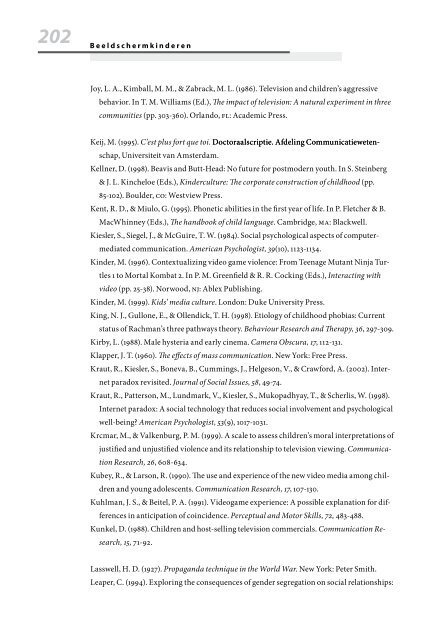Download PDF: Beeldschermkinderen - Kijkwijzer
Download PDF: Beeldschermkinderen - Kijkwijzer
Download PDF: Beeldschermkinderen - Kijkwijzer
Create successful ePaper yourself
Turn your PDF publications into a flip-book with our unique Google optimized e-Paper software.
202 <strong>Beeldschermkinderen</strong><br />
Joy, L. A., Kimball, M. M., & Zabrack, M. L. (1986). Television and children’s aggressive<br />
behavior. In T. M. Williams (Ed.), The impact of television: A natural experiment in three<br />
communities (pp. 303-360). Orlando, FL: Academic Press.<br />
Keij, M. (1995). C’est plus fort que toi. Doctoraalscriptie. Afdeling Communicatieweten-<br />
Communicatieweten-<br />
schap, Universiteit van Amsterdam.<br />
Kellner, D. (1998). Beavis and Butt-Head: No future for postmodern youth. In S. Steinberg<br />
& J. L. Kincheloe (Eds.), Kinderculture: The corporate construction of childhood (pp.<br />
85-102). Boulder, Co: Westview Press.<br />
Kent, R. D., & Miulo, G. (1995). Phonetic abilities in the first year of life. In P. Fletcher & B.<br />
MacWhinney (Eds.), The handbook of child language. Cambridge, MA: Blackwell.<br />
Kiesler, S., Siegel, J., & McGuire, T. W. (1984). Social psychological aspects of computer-<br />
mediated communication. American Psychologist, 39(10), 1123-1134.<br />
Kinder, M. (1996). Contextualizing video game violence: From Teenage Mutant Ninja Tur-<br />
tles 1 to Mortal Kombat 2. In P. M. Greenfield & R. R. Cocking (Eds.), Interacting with<br />
video (pp. 25-38). Norwood, NJ: Ablex Publishing.<br />
Kinder, M. (1999). Kids’ media culture. London: Duke University Press.<br />
King, N. J., Gullone, E., & Ollendick, T. H. (1998). Etiology of childhood phobias: Current<br />
status of Rachman’s three pathways theory. Behaviour Research and Therapy, 36, 297-309.<br />
Kirby, L. (1988). Male hysteria and early cinema. Camera Obscura, 17, 112-131.<br />
Klapper, J. T. (1960). The effects of mass communication. New York: Free Press.<br />
Kraut, R., Kiesler, S., Boneva, B., Cummings, J., Helgeson, V., & Crawford, A. (2002). Inter-<br />
net paradox revisited. Journal of Social Issues, 58, 49-74.<br />
Kraut, R., Patterson, M., Lundmark, V., Kiesler, S., Mukopadhyay, T., & Scherlis, W. (1998).<br />
Internet paradox: A social technology that reduces social involvement and psychological<br />
well-being? American Psychologist, 53(9), 1017-1031.<br />
Krcmar, M., & Valkenburg, P. M. (1999). A scale to assess children’s moral interpretations of<br />
justified and unjustified violence and its relationship to television viewing. Communication<br />
Research, 26, 608-634.<br />
Kubey, R., & Larson, R. (1990). The use and experience of the new video media among children<br />
and young adolescents. Communication Research, 17, 107-130.<br />
Kuhlman, J. S., & Beitel, P. A. (1991). Videogame experience: A possible explanation for differences<br />
in anticipation of coincidence. Perceptual and Motor Skills, 72, 483-488.<br />
Kunkel, D. (1988). Children and host-selling television commercials. Communication Research,<br />
15, 71-92.<br />
Lasswell, H. D. (1927). Propaganda technique in the World War. New York: Peter Smith.<br />
Leaper, C. (1994). Exploring the consequences of gender segregation on social relationships:







